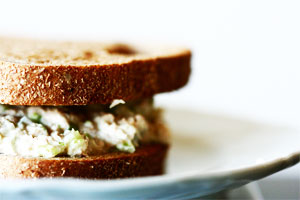
Which is worse for you, a can of tuna or a broken CFL bulb? Sorry, Charlie... image by Dave Lifson
A paper expected to be published in the August issue of the lighting industry journal, LD+A, may quiet some of the controversy over the dangers of mercury in compact fluorescent lights (CFL). I’ve argued in this blog that the cut in mercury emissions from power plants due to the electricity saved when traditional incandescent bulbs are replaced with CFLs, greatly outweighs the amount of mercury that could escape from broken CFLs, plus what is emitted during the making and transportation of CFLs. But the paper, by Robert Clear, Francis Rubinstein, and Jack Howells, who do research at Lawrence Berkeley National Laboratory (LBNL), goes a step farther by showing that even a person who breaks a lamp is more at risk from mercury in the environment than from the mercury in the lamp itself.
The researchers point out that there is a distinction between the kind of mercury that you are exposed to from broken CFLs—elemental mercury—and the mercury emitted from power plant smokestacks after it finds it’s way into waterways and oceans, where it becomes methyl mercury. Methyl mercury accumulates all up the food chain, so that large fish like tuna can contain a lot of it. Methyl mercury crosses the blood-brain barrier and passes through a pregnant woman’s placenta to her fetus. Methyl mercury is responsible for developmental problems, while elemental mercury, which is inhaled, appears to be more of a hazard for adults and children, and only then in the case of severe or prolonged exposures. In most mild cases, when the elemental mercury exposure ends, the bad effects diminish and go away. This is unfortunately not true for the developmental problems caused by methyl mercury.
The startling conclusion of the paper is that in a worse case scenario—you break a CFL in a closed, unventilated room; you vacuum the carpet, throwing mercury into the air; you set the vacuum in a corner; and then sit in the room breathing for eight hours—the amount of mercury exposure is about equivalent to the exposure you’d get from eating a can of Albacore tuna.
Eating a can of tuna has positive health effects as well as the negative health effects from the mercury. There are no positive health effects from a broken CFL, and you can reduce your exposure. The researchers suggest that in the case of a broken CFL, you should immediately open a nearby window. You can limit contamination by gathering up the large pieces of the broken bulb into a bag and set the bag outside. The room should then be left to air out for an hour or so. If the lamp broke on a carpet you can vacuum, but it should be done quickly while the room is being ventilated, the vacuum cleaner should be removed to an outside area, and again the room should be left vacated for an hour or so. Once the vacuum cleaner has cooled, you can empty the contents of the vacuum cleaner bag into the bag with the broken bulb. Take the bag to your nearest recycling center.
